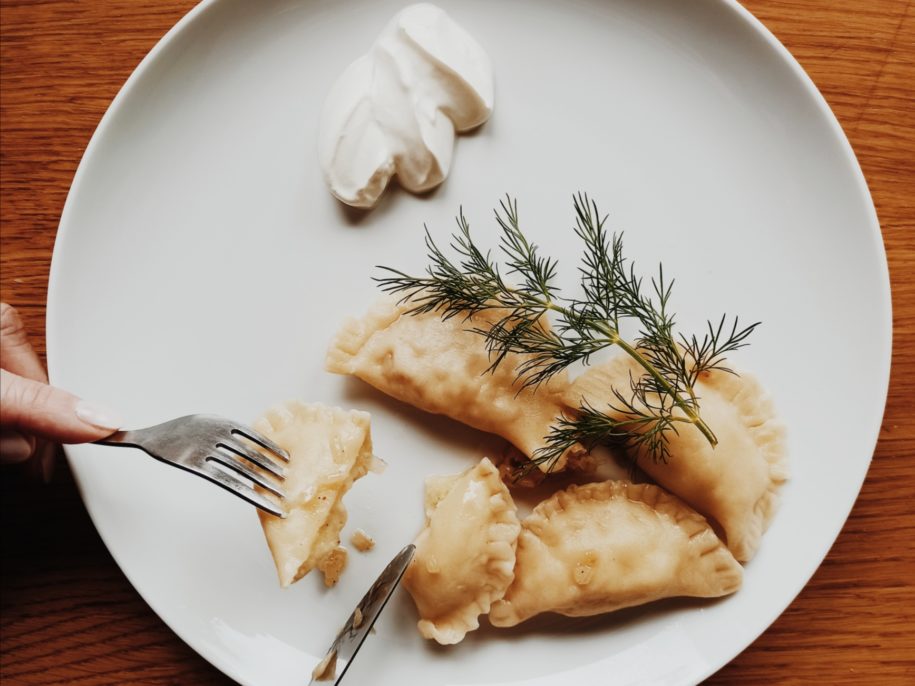 Polska wersja wpisu poniżej.
Polska wersja wpisu poniżej.
Today Forklore comes up with an idea for Sunday dinner to be made during your #stayhome time! Have you got a lot of free time? Best way to spend it is by… making the dumplings!
‘Pierogi’ – the most famous Polish dish and one of the first words in Polish learned by foreigners visiting our country (along with… ‘dziękuję’ obviously!).
We must admit, it is not common for us to make the dumplings ourselves because it’s a pretty time-consuming process, but we simply love eating them. Well, who doesn’t?
This time we suggest to prepare dumplings in two flavours: traditional ‘russian’ pierogi (with potatoes and cottage cheese) and ‘lubelskie’ (with buckwheat, bacon and cottage cheese) – popular mainly in Lubelskie region. Both served with fried onion and cream – yummy!
So, let’s get down to work!
Below recipe comes from the book “In Old Polish kitchen and at the Polish table” from 1986. Ingredients for about 60-70 dumplings.
‘Russian’ filling:
For dumplings called “Russian” we pass through a meat grinder ½ kg of boiled potatoes with 15 dag of white cottage cheese. Add 1 small raw egg, finely chopped and fried onion, salt and pepper to taste.
‘Lubelskie’ filling:
Cook 50 g of buckwheat and cool it. Fry 120 g of bacon in a frying pan, add chopped medium onion and fry it together for a while. In a bowl, mix together buckwheat, fried bacon and onion together with 250 g of crushed cottage cheese and 60 g of sour cream 12%. Season it all to taste with salt and pepper.
Dough for dumplings:
Put on a moulding board 35 dag of flour, a pinch of salt, 1 whole egg and knead the dough adding a bit of lukewarm water. A well-made dough should not stick to the hands and the board. Divide the dough into four parts and cover them with a bowl so it won’t dry. Roll out each part quite thinly and cut out 5-6cm diameter circles with a glass. Put a heaped teaspoon of filling on each circle, then fold the circle in half, tightly clamping the edges by hand or fork so that the dumpling does not open during cooking. Dumplings should be well filled.
Cook the formed dumplings in a shallow, wide pot, in a large amount of lightly salted water. When they come out on top, cook them on low heat for 4-5 minutes, then take them out with a skimmer and put well drained on a plate.
Serve topped with melted butter, pork fat with cracklings our sour cream. And enjoy your well deserved moment of pleasure by eating as many dumplings as possible! 😉
Dużo wolnego czasu? W sam raz na… przygotowanie pierogów! W ramach akcji #zostańwdomu, Forklore tym razem poleca się z pomysłem na niedzielny obiad!
‘Pierogi’ – najbardziej znane polskie danie i jedno z pierwszych słów, jakie poznają obcokrajowcy odwiedzający nasz kraj (zaraz obok… ‘dziękuję’ oczywiście!).
Przyznajemy, że nieczęsto decydujemy się na własnoręczne przygotowywanie pierogów ze względu na ich czasochłonność, za to uwielbiamy je zajadać. Z resztą, czy jest ktoś, kto nie kocha pierogów?
Tym razem proponujemy pierogi w dwóch wersjach smakowych: tradycyjne ruskie (z ziemniakami i twarogiem) oraz lubelskie (z kaszą gryczaną, boczkiem i twarogiem) – popularne głównie na Lubelszczyźnie. Koniecznie serwowane z cebulką i śmietaną – mniam!
Zatem – do pracy (rodacy)!
Przepis pochodzi z książki „W staropolskiej kuchni i przy polskim stole” z 1986 roku. Składniki na ok. 60-70 pierogów.
Nadzienie ruskie:
Na pierogi zwane „ruskimi” przepuszczamy przez maszynkę do mielenia mięsa (lub zwyczajnie rozduszamy) ½ kg ugotowanych ziemniaków z 15 dag białego sera (twarogu). Do zmielonej masy dodajemy 1 małe surowe jajo, drobno posiekaną i usmażoną na złoty kolor średnią cebulę oraz sól i pieprz do smaku.
Nadzienie lubelskie:
50 g kaszy gryczanej gotujemy na sypko i studzimy. Na patelni podsmażamy 120 g boczku, dodajemy posiekaną średnią cebulę i smażymy chwilę razem do zeszklenia. W misce mieszamy razem rozkruszone 250 g twarogu, kaszę i podsmażony boczek z cebulą oraz 50-60 g śmietany 12%. Przyprawiamy do smaku solą i pieprzem.
Ciasto na pierogi:
Zagniatamy na stolnicy ciasto z 35 dag mąki, szczypty soli, 1 całego jaja, dolewając po trochu letniej wody, by otrzymać ciasto dość wolne i doskonale wyrobione, nie lepiące się do rąk i stolnicy. Ciasto (nakryte miską, by nie obeschło) dzielimy na 4 części, z których kolejno każdą dość cienko rozwałkowujemy. Z ciasta wycinamy szklanką krążki o średnicy 5-6cm, na każdy krążek nakładamy czubatą łyżeczkę nadzienia, po czym krążek składamy na pół, silnie zaciskając brzegi, by pieróg nie otworzył się w czasie gotowania. Pierogi powinny być dobrze wypełnione i tuż przy brzegu dobrze zlepione.
Uformowane pierogi gotujemy w płytkim, szerokim garnku, w dużej ilości lekko posolonej wody. Gdy wypłyną na wierzch, gotujemy je jeszcze na małym ogniu przez 4-5 minut, po czym wyjmujemy cedzakową (dziurkowaną) dużą łyżką i dobrze osączone kładziemy na półmisek.
Pierogi polewamy masłem albo słoniną ze skwarkami. Oddzielnie podać możemy gęstą, lekko kwaśną śmietanę. I w ramach nagrody za ciężką pracę oddać się błogiemu zajadaniu! 😉


Leave a Reply